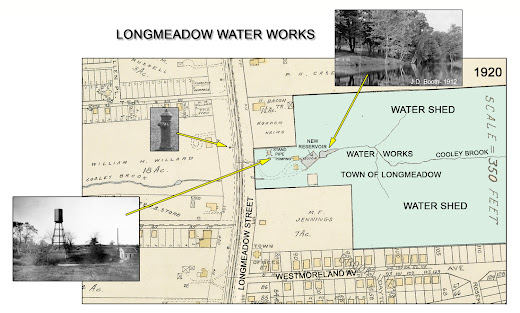The Early Days
In the mid-19th century, Longmeadow had a primitive water system. A private company created a public water supply from Cooley Brook. A large waterwheel was connected to a pump that brought water from the brook which was then conveyed through hollowed out pine logs buried underground to a set of two public water tubs. Additional pipes carried water to houses and barns. However, the logs leaked so much that the system was abandoned after several years. See the earlier Longmeadow Historian blog post --> Longmeadow’s First Public Water Supply.
The Landmark Water Tower
In the late 19th century Longmeadow embarked on a mission to establish a modern water system. The town purchased land along Cooley Brook for the water works and water shed. The water works included a covered basin to settle out sand and a roofed storage reservoir with a capacity of 65,000 gallons. A 105-foot standpipe, or water tower, was constructed, which became a highly visible landmark. Water was pumped from the storage reservoir into the water tower.
 | ||
| Water Tower- Longmeadow Street Longmeadow Historical Society archives |
 |
| Longmeadow Water Works- 1920 [click image to enlarge] |
The tower, consisting of an 88,000-gallon steel tank set atop a 70-foot steel trestle, stood for forty-two years off Longmeadow Street near the present St. Andrew's Episcopal Church. About nine acres of land along the Cooley Brook east of Longmeadow Street were purchased for the water plant and watershed. The town’s layout made the construction of a public water supply system practical. Main lines were laid out along Longmeadow Street, with lateral lines extending to the side streets. The springs that fed Cooley Brook were chosen to provide the town with water.
From the tower, water flowed under pressure in mains throughout the town, providing a sufficient supply of clean water certified by the state Board of Health for residential use and also for the first time supplying enough water for fire protection.
Expansion and Modernization
As Longmeadow's population expanded, additional watershed lands were purchased along Cooley Brook, the reservoir was enlarged, and a new concrete reservoir was built.
In 1912, the town took two important steps to ensure its future supplies: the installation of meters to encourage water conservation and an emergency connection with the city of Springfield. The meters led to a considerable reduction in water usage.
The Shift to Springfield Water Supply
In 1922, the emergency connection with Springfield (Little River system) was opened permanently, and Longmeadow abandoned its waterworks, becoming fully dependent on Springfield for its water supply.
The Post-War Era
Despite further engineering improvements in the distribution system, water pressure failed to keep up with the accelerated building of homes in the post-war period. The prolonged drought of the 1960s, together with uncertainty about Springfield's reliability as a supplier, led the town to think about its future water supply. Two solutions were chosen: the building of a million gallon water tower off Frank Smith Road in 1965 and in 1971 the drilling of two wells. These wells could produce 1 million gallons of drinkable water daily and
were intended to provide the town's primary water supply, supplemented
by water from Springfield during the summer months. These two wells were
later closed.
 |
| Water Tower- Frank Smith Road [photo courtesy of Longmeadow Water Department] |
Today’s Water Supply
The Town of Longmeadow currently purchases all of its water from the City of Springfield which originates from the Cobble Mountain Reservoir located in Western Massachusetts near the towns of Russell and Blandford. This water supply is filtered and chlorinated before it is delivered to Longmeadow. The Longmeadow water system begins at the Water Pumping Station located on Forest Glen Road in Longmeadow where fluoride is added. From this pumping station, the Town of Longmeadow is serviced by approximately 96 miles of water distribution mains.
 |
| Longmeadow Pumping Station- Forest Glen Road [photo courtesy of Longmeadow Water Department] |
Conclusion
The history of Longmeadow’s water system is a tale of innovation, community effort, and adaptation to changing needs. From the early days of hollowed out logs to the modern piped-water system, Longmeadow's water system has evolved to meet the needs of its residents, reflecting the town’s commitment to ensuring a reliable and safe water supply.
_____________________________________________
Levels of disinfectant byproducts (chlorination byproducts) have periodically exceeded maximum allowable water quality guidelines in recent years. The Springfield Water and Sewer Commission is aware of the problem and have plans in place to improve the water quality of their system. A new West Parish Water Treatment Plant will incorporate new treatment technology to resolve issues with disinfectant byproducts. Construction is scheduled to begin in 2024 and is expected to be completed in mid-2028.
Written by Jim Moran/ Guest Historian










